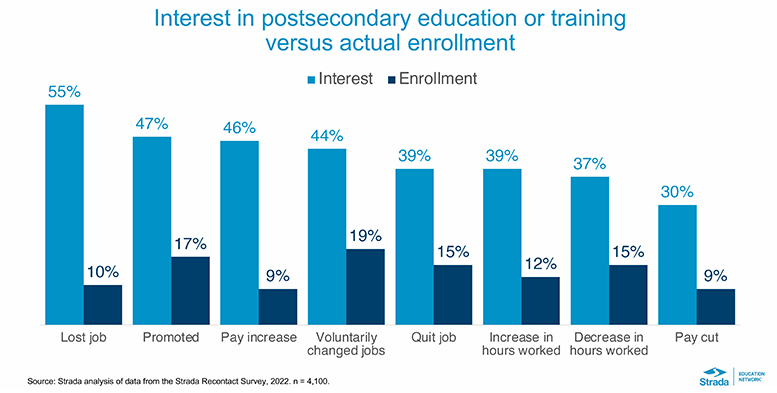Individuals who left their jobs voluntarily since the start of the Covid pandemic were more likely to enroll in postsecondary education than those who lost their jobs, according to a new report from the Strada Education Network.
The biggest influence on voluntary job switchers to enroll was whether they thought the program would result in a good-paying job or opportunities for career advancement, says the report, which is based on a spring 2022 survey of 4,500 adults between ages 18 and 65 about the employment and education changes they have experienced since the start of the pandemic.
A full 80% of those who enrolled indicated economic opportunity influenced them, followed by program flexibility (69%) and work-based learning opportunities (48%). Flexibility was more important for women than men (57% compared to 42%) and for students of color (60% or more for students who are Black/African-American, Asian or Hispanic/Latino compared to 43% for white students).

Uncertain about the value
Among individuals who didn’t enroll in postsecondary education since the start of the pandemic, 39% said the main reason was a lack of confidence in the value of education, according to the report.
“Even among people who had reported in an earlier survey that they were likely to enroll, a lack of confidence in education’s value kept nearly a quarter from doing so,” the report says.
For about one-fifth (18%) of those who haven’t enrolled, cost was a factor, followed by concerns about balancing school with work, childcare and other obligations (15%). More than one-quarter of parents indicated this as the primary reason for not enrolling, compared with 9% of people without minors living in the house, the report says.
A closer look at those who lost their jobs
More than half of people who lost their job indicated that they were interested in education, which Strada noted was consistent with earlier findings. However, they were the least likely to enroll and had the largest gap between interest and enrollment (45 percentage points), the report says.
“Concerns about the cost of education, which our data show to be a persistent and formidable barrier to enrollment, may prevent those with a sudden loss of income from starting a program, even those who are interested in education,” Strada says.
Yet cost was not the biggest consideration for those who lost their jobs but didn’t enroll: nearly one-third (31%) indicated they lacked confidence in the value of postsecondary education and training. For one-quarter of them (26%), cost was the main barrier.
Strada also examined perceptions of employer-provided education, which drew interest among those who voluntarily left and those who lost their jobs. With almost three-quarters of people who quit their jobs saying they would be interested in employer-provided training, offering this opportunity could be a strategy for engagement and recruitment, the report says.

